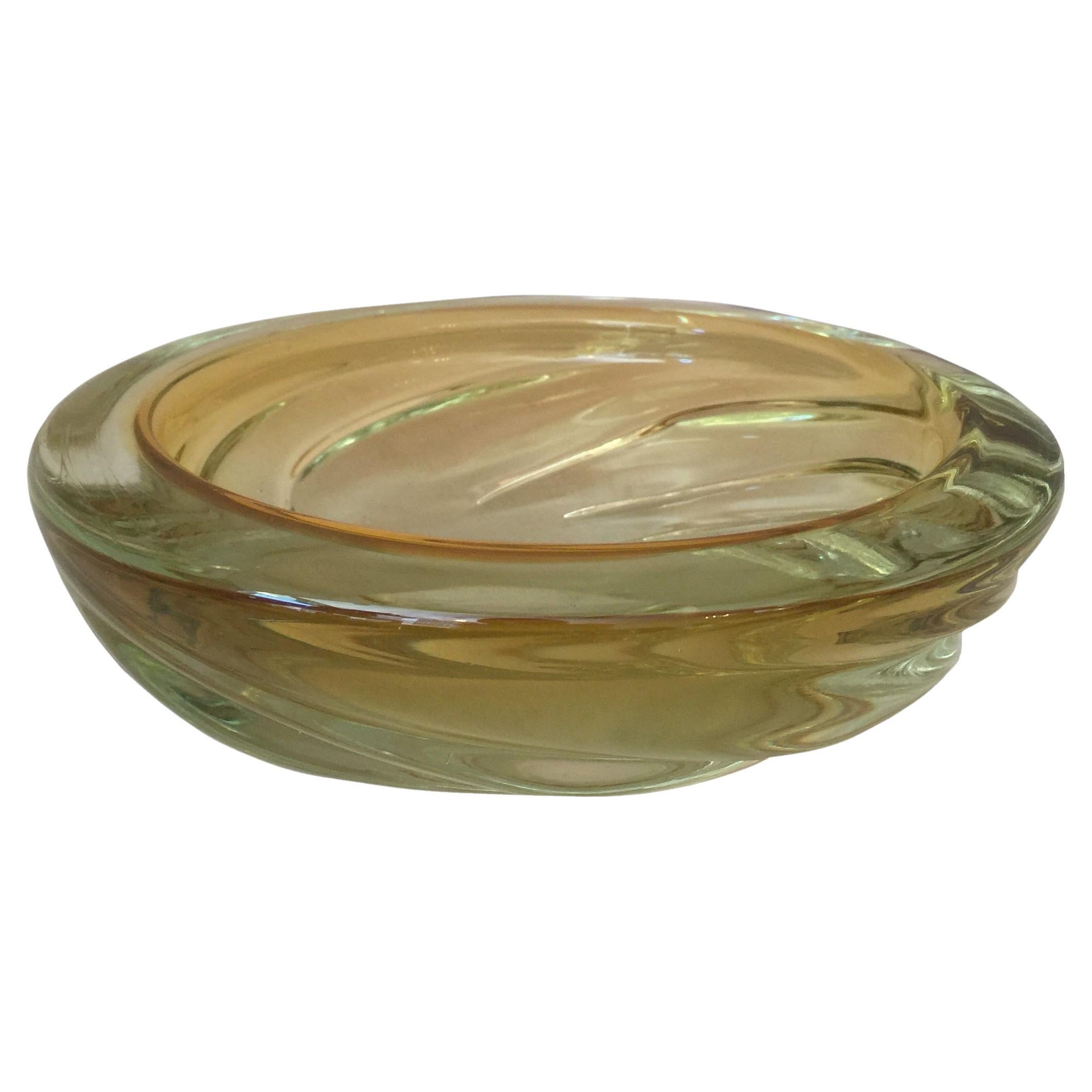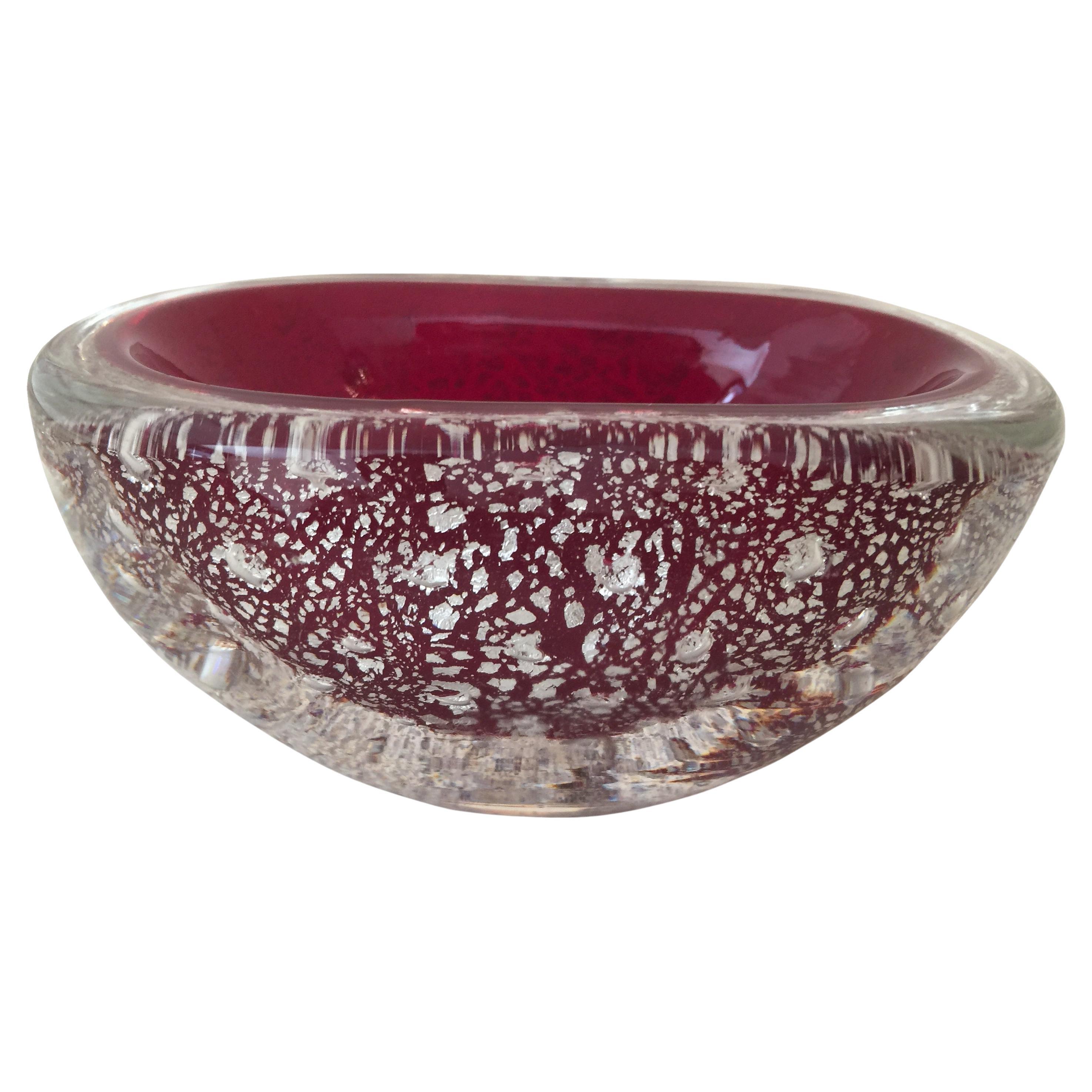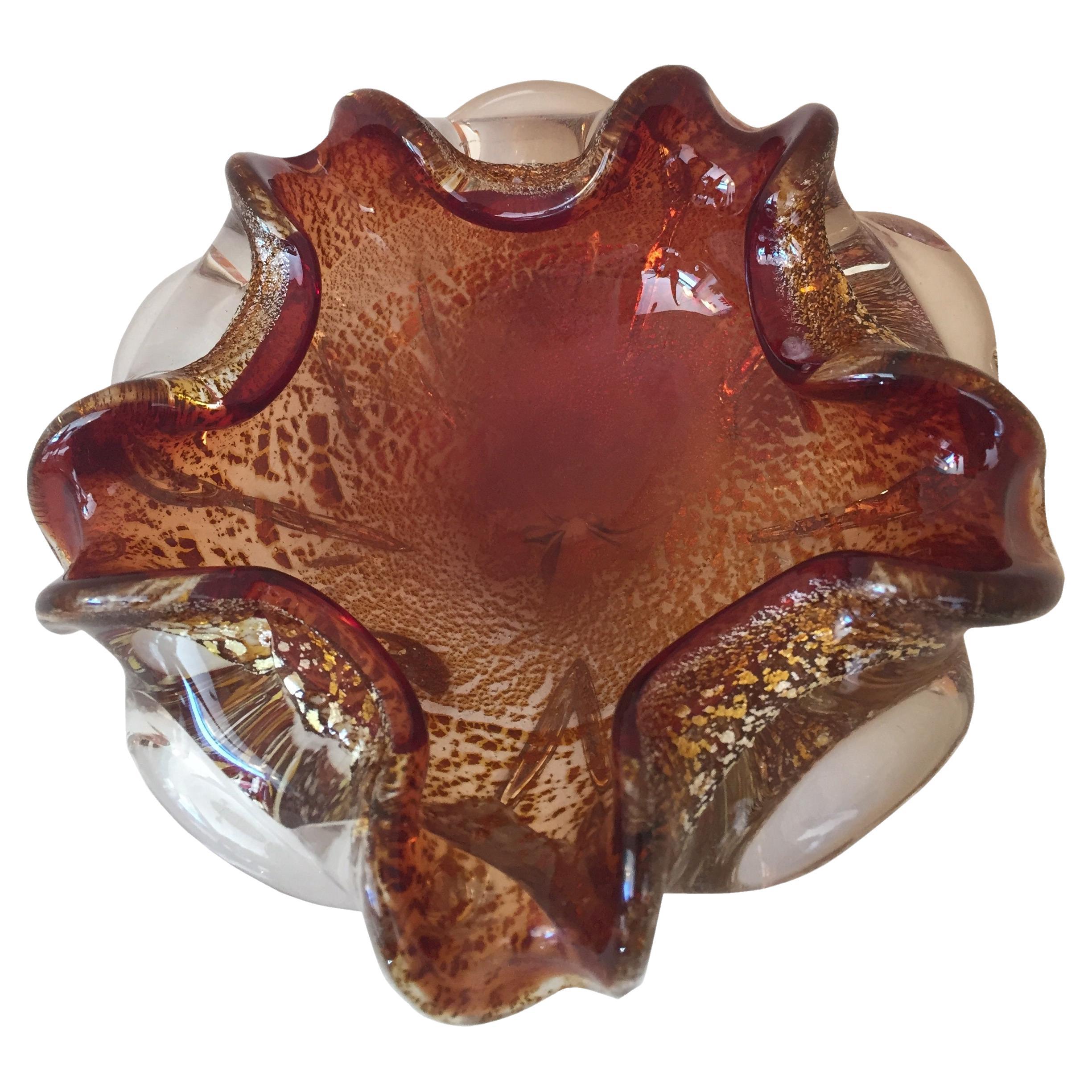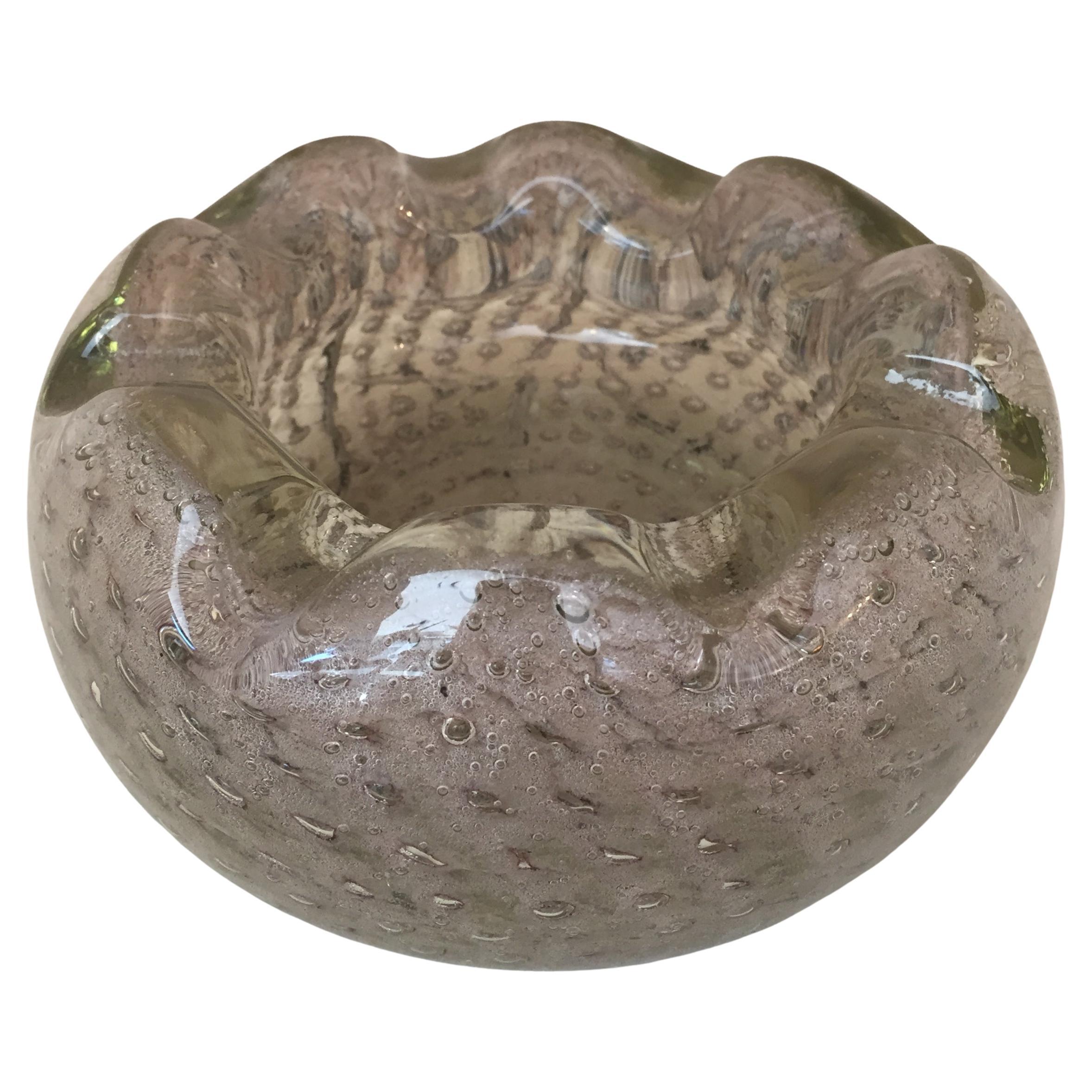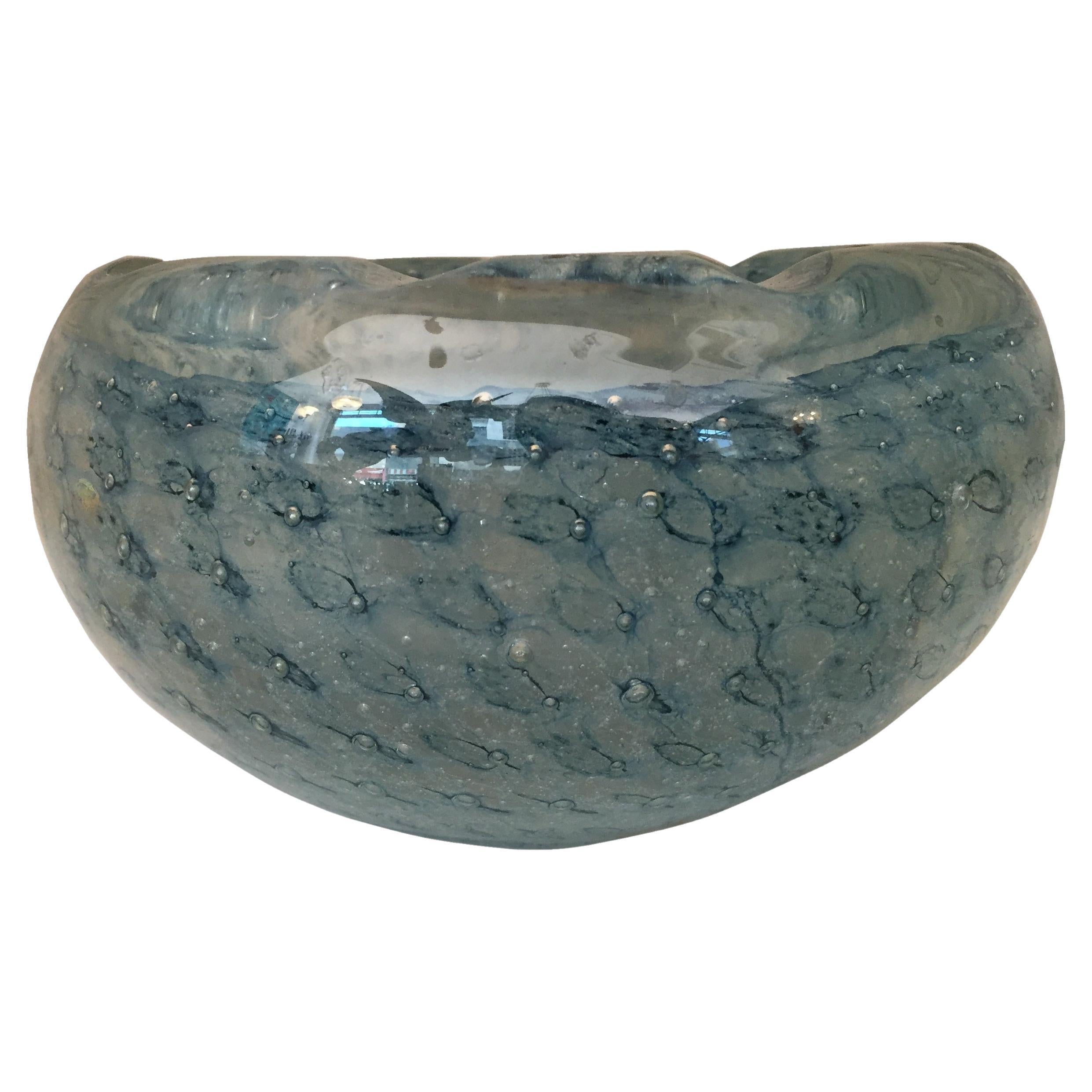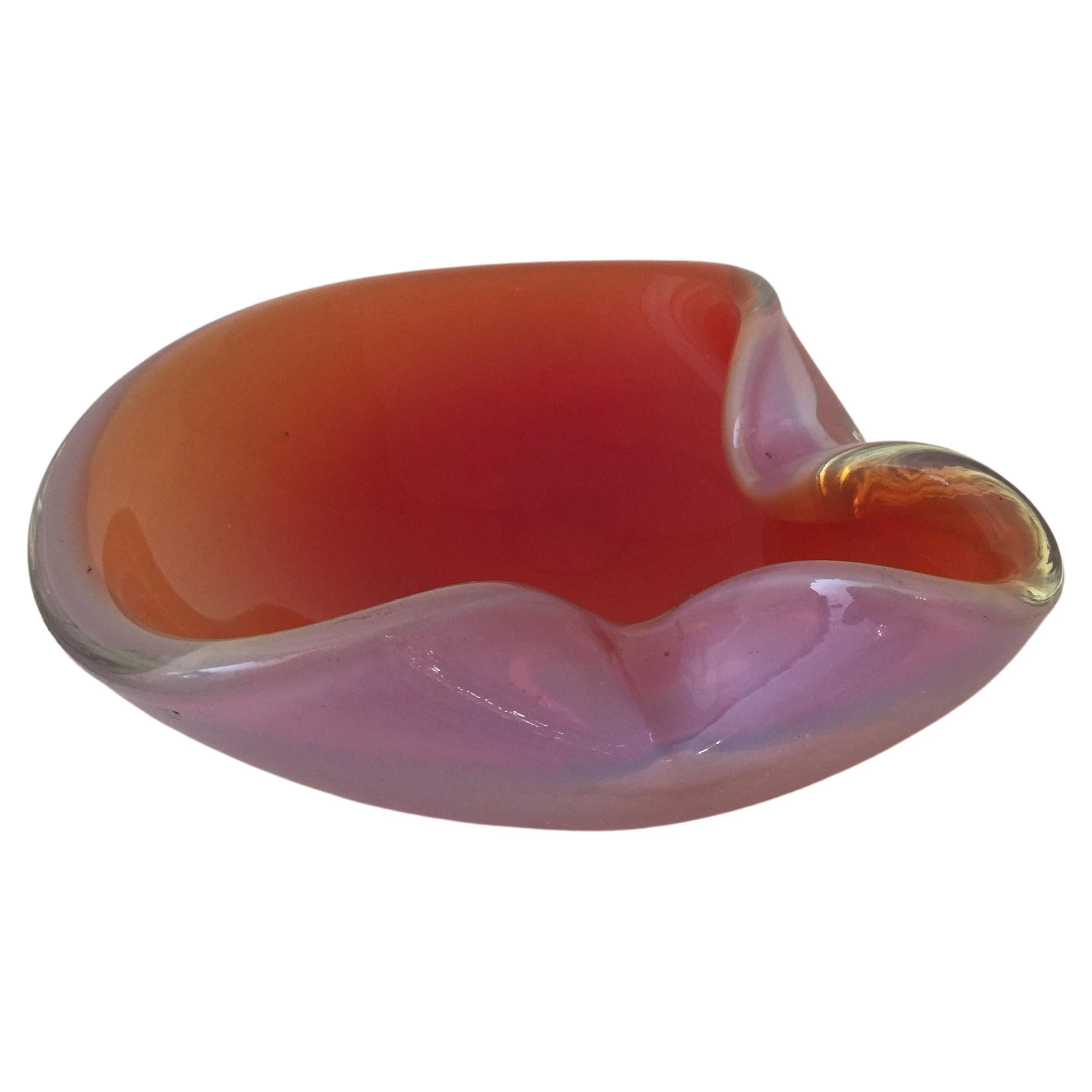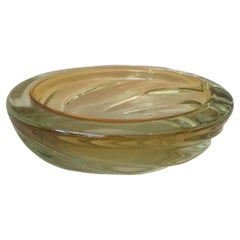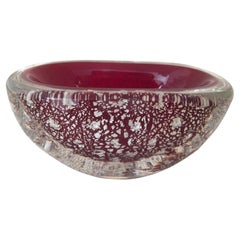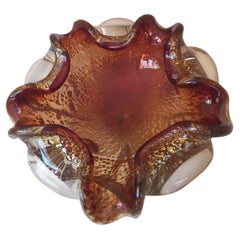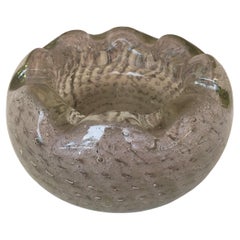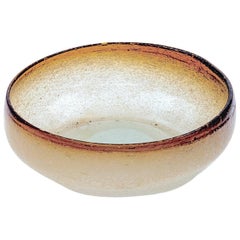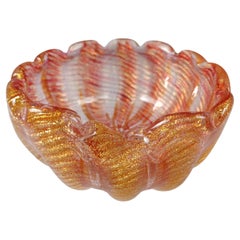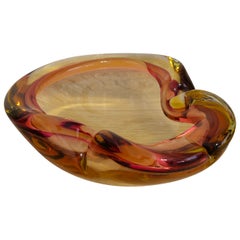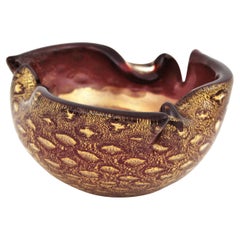Items Similar to Murano and gold, Italian, Attributed to, Seguso Barovier, 1930
Video Loading
Want more images or videos?
Request additional images or videos from the seller
1 of 10
Murano and gold, Italian, Attributed to, Seguso Barovier, 1930
$2,700
£2,004.61
€2,335.92
CA$3,748.47
A$4,192.90
CHF 2,182.01
MX$51,616.05
NOK 27,759.70
SEK 26,044.07
DKK 17,428.28
Shipping
Retrieving quote...The 1stDibs Promise:
Authenticity Guarantee,
Money-Back Guarantee,
24-Hour Cancellation
About the Item
Murano
We have specialized in the sale of Art Deco and Art Nouveau and Vintage styles since 1982. If you have any questions we are at your disposal.
Pushing the button that reads 'View All From Seller'. And you can see more objects to the style for sale.
The history of "Seguso Vetri D' Arte" is directly linked to the "Vetreria Artistica Barovier" company. When the Barovier workshop was forced to reduce production in 1929, due to a financial crisis in America, the
original group of ten partners had to separate and Antonio Seguso in 1931, assisted by his sons Ernesto and Archimede opened a small workshop of his own. They were joined by Luigi Olimpio Ferro and Napoleone Barovier the following year. Together the craftsmen establish the "Artistica Soffieria e Vetreria Barovier Seguso & Ferro" company as equal partners.
In 1934 Flavio Poli joins the firm as artistic director and within only a brief period of time a distinct style of designs emerged. The close collaboration between Flavio Poli, Archimede Seguso and Alfredo Barbini played an important part in the success of the company. New glass techniques are developed which include never before seen color applications.
The companies innovative designs constantly received awards and during the 1935 World Fair in Brussels and the 1936 Milan Triennale they did attract the interest of a new group of clientele. One of them is the French wholesale company "Veronese" from Paris which would play a defining role in the history of the company.
The demand for an increase in production requires additional investments and the partners felt that there is a need to multiply their investment tenfold.
Luigi Olimpio Ferro subsequently decided to withdraw from the company and his shares are acquired by Flavio Poli, which makes him a full partner. As a result, the company name is changed to Seguso Vetri D’ Arte and it is officially recognized in 1937. A period of great success and prosperity ensues, lasting until the outbreak of World War II.
The post war period is a time of great change in Europe and the rebuilding of the economical structure in Italy requires major investments which result in the introduction of new import duties and taxes.
To safeguard the copyright of the Seguso Vetri D'Arte designs an application for a second entry into the commercial registers of Venice is made by the partners in 1945.
Strict export regulations curb international business relations for many years after the war and the company decides to focus on the domestic market instead. In 1946 a large retail location is opened at the Piazza Diaz in Milan where in addition to the art glass, German porcelain and Italian pottery is offered.
In 1950 Flavio Poli develops a new sommerso glass technique, which consists of an overlaying of transparent layers of glass. The overlapping creates new shades of color which prior to the introduction of this technique had not been seen. Flavio Poli's most iconic design is the "Valve", which resembles an upright, slightly opened clam shell. The design was introduced in 1951. Mario Pinzoni joins the company in 1953 as a personal assistant to Flavio Poli and his responsibilities as a draftsman included the compilation of archival and the existing production drawing s into in a single company catalogue. The continuous increase in prosperity during the 1950s brings financial security to the glass company and Flavio Poli once more sets out to experiment with new glass techniques. Contrary to the preceding series of "Sommersi" objects, none of the new series become commercially successful, and the production is soon abandoned. Poli returns to develop additional sommersi designs with new colour applications including topaz and sapphire shades of color combined with violet which is introduced during the Biennale in 1957. A shift in ownership due to the passing of Napoleone Barovier and the withdrawal of Antonio Seguso, put Ernesto Seguso and Flavio Poli at the head of the company management. Conflicts with Bruno and Angelo Seguso concerning artistic direction cause Flavio Poli to resign in 1963 and Mario Pinzoni takes over the artistic leadership. He introduces new colors and models, yet maintains the basic "sommerso" technique which has become the company’s trademark. The costly production of these objects and and an increase in competition cause the once so solid structure of the company to collapse. Pinzoni decides to leave the company in 1971, and Vittorio Rigattieri is hired yet he is unable to turn the tide. In 1973 Seguso Vetri D’Arte ceases its production. The hiring of Maurizio Albarelli in 1978 proves as saving grace of the Seguso Vetri D' Arte company archives which were therefore preserved and which nowadays belong to the Fondazione Cini on San Giorgi and the Seguso family on Murano.
-----------------------------
La historia de "Seguso Vetri D'Arte" está directamente ligada a la empresa "Vetreria Artistica Barovier". Cuando el taller de Barovier se vio obligado a reducir la producción en 1929, debido a una crisis financiera en América, el
El grupo original de diez socios tuvo que separarse y Antonio Seguso en 1931, asistido por sus hijos Ernesto y Arquímedes abrió un pequeño taller propio. A ellos se unieron Luigi Olimpio Ferro y Napoleone Barovier al año siguiente. Juntos, los artesanos establecen la empresa "Artistica Soffieria e Vetreria Barovier Seguso & Ferro" como socios iguales.
En 1934 Flavio Poli se une a la firma como director artístico y en tan solo un breve período de tiempo surgió un estilo distintivo de diseños. La estrecha colaboración entre Flavio Poli, Archimede Seguso y Alfredo Barbini jugó un papel importante en el éxito de la empresa. Se desarrollan nuevas técnicas de vidrio que incluyen aplicaciones de color nunca antes vistas.
Los diseños innovadores de las empresas recibieron constantemente premios y durante la Exposición Universal de Bruselas de 1935 y la Trienal de Milán de 1936 atrajeron el interés de un nuevo grupo de clientes. Una de ellas es la empresa mayorista francesa "Veronese" de París que jugaría un papel definitorio en la historia de la empresa.
La demanda de un aumento en la producción requiere inversiones adicionales y los socios sintieron que existe la necesidad de multiplicar por diez su inversión.
Posteriormente, Luigi Olimpio Ferro decidió retirarse de la empresa y sus acciones son adquiridas por Flavio Poli, lo que lo convierte en socio de pleno derecho. Como resultado, el nombre de la empresa se cambia a Seguso Vetri D'Arte y se reconoce oficialmente en 1937. Se produce un período de gran éxito y prosperidad, que dura hasta el estallido de la Segunda Guerra Mundial.
El período de la posguerra es una época de grandes cambios en Europa y la reconstrucción de la estructura económica en Italia requiere grandes inversiones que se traducen en la introducción de nuevos impuestos y derechos de importación.
Para salvaguardar los derechos de autor de los diseños de Seguso Vetri D'Arte, los socios solicitan una segunda entrada en los registros comerciales de Venecia en 1945.
Las estrictas normas de exportación frenan las relaciones comerciales internacionales durante muchos años después de la guerra y, en su lugar, la empresa decide centrarse en el mercado nacional. En 1946 se abre un gran local comercial en la Piazza Diaz de Milán, donde además del arte en vidrio, se ofrece porcelana alemana y cerámica italiana.
En 1950 Flavio Poli desarrolla una nueva técnica de vidrio sommerso, que consiste en una superposición de capas transparentes de vidrio. La superposición crea nuevos matices de color que antes de la introducción de esta técnica no se habían visto. El diseño más icónico de Flavio Poli es la "Válvula", que se asemeja a una concha de almeja vertical y ligeramente abierta. El diseño fue introducido en 1951.
Mario Pinzoni se une a la empresa en 1953 como asistente personal de Flavio Poli y sus responsabilidades como dibujante incluían la compilación de archivos y los dibujos de producción existentes en un solo catálogo de la empresa. El continuo aumento de la prosperidad durante la década de 1950 trae seguridad financiera a la empresa de vidrio y Flavio Poli una vez más se propone experimentar con nuevas técnicas de vidrio. A diferencia de la serie anterior de objetos "Sommersi", ninguna de las nuevas series tiene éxito comercial y la producción pronto se abandona. Poli vuelve a desarrollar diseños sommersi adicionales con nuevas aplicaciones de color que incluyen tonos de color topacio y zafiro combinados con violeta que se presentó durante la Bienal de 1957. Un cambio en la propiedad debido al fallecimiento de Napoleone Barovier y la retirada de Antonio Seguso, puso a Ernesto Seguso y Flavio Poli al frente de la dirección de la empresa. Conflictos con Bruno y Angelo Seguso en la dirección artística hacen que Flavio Poli renuncie en 1963 y Mario Pinzoni asume la dirección artística. Introduce nuevos colores y modelos, pero mantiene la técnica básica del "sommerso" que se ha convertido en la marca registrada de la empresa. La costosa producción de estos objetos y el aumento de la competencia hacen que la antaño tan sólida estructura de la empresa se derrumbe. Pinzoni decide dejar la empresa en 1971 y se contrata a Vittorio Rigattieri, pero no puede cambiar el rumbo. En 1973 Seguso Vetri D'Arte cesa su producción. La contratación de Maurizio Albarelli en 1978 resulta ser la salvación de los archivos de la empresa Seguso Vetri D'Arte que, por lo tanto, se conservaron y que hoy pertenecen a la Fondazione Cini en San Giorgi ya la familia Seguso en Murano.
Why are there so many antiques in Argentina?
In the 1880 – 1940 there was a grate wave of immigration encouraged by the periods of war that were taking place.
1st World War took place between 1914 and 1918
2nd World War took place between 1939 and 1945
The immigrants options were New York or Bueno Aires. Tickets were cheap and in Buenos Aires they were welcomed with open arms, as it was a country where everything was still to be done.
Argentina was the country of new opportunities, labour was needed and religious freedom was assured, in many cases the of the family travel first until they were settled and then the rest of the family members join them.
In the immigrant museum “Ellis Island Immigrant Building” in New York you can se the promotional posters of the boats that would take them to a new life.
Between the years 1895 and 1986, Argentina had the highest DGP (gross domestic product) per capita in the world according to the Maddison Historical Statistics index, this situation arose due to the large amount of food being exported to European countries, which were at war.
The Argentinean ships left the port of Buenos Aires with food, but they returned with furniture, clothes and construction elements, (it´s common to see this the old buildings of the historic neighbourhood of San Telmo, the beams with the inscription “Made in England)”, as well as many markets that were built in Buenos Aires, such us the San Telmo Market, whose structure was brought by ship and afterwards assembled in 900 Defensa Street.
With the great influence of European immigrants living in the country, the children of the upper classes travelled to study in France, resulting in the inauguration of “La Maison Argentinienne”, on 27th of June 1928, in the international city of Paris, which hosted many Argentinians that were studying in Frace.
It´s the fourth house to be built after France, Canada and Belgium, being the first Spanish-speaking one. Still in place today (17 Bd Jourdan, 75014, Paris, France). Many of the children of these wealthy families who attended international art exhibitions, museums and art courses abroad, took a keen interest in the European style. This is why Buenos Aires was at the time referred as “The Paris of South America”.
Between the years 1890 and 1920 more than a hundred Palaces were built on Alvear Avenue the most exclusive avenue in Buenos Aires. Today some of these palaces have been transformed into museums, hotels and embassies.
In the year 1936, the Kavanagh building was inaugurated, it was the tallest reinforced concrete building in South America.
During 1994 the American Society of Civil Engineers distinguished it as an “international engineering milestone”, and it´s now considered a World Heritage of Modern Architecture.
At the time was common to hire foreign architects such as Le Corbusier, who visited Buenos Aires/Argentina in 1929 and in 1948 he drew up the blueprints for a house built in La Plata City (which was declared a World Heritage Site).
In 1947, the Hungarian architect Marcelo Breuer designed “Parador Ariston” in the seaside city of Mar del Plata. After an Argentinean student at Harvard University convinced him to come to Argentina. He worked on an urban development project in the Casa Amarilla, area of La Boca.
The Ukrainian architect, Vladimiro Acosta, arrives in Argentina in 1928 and worked as an architect until que moved to Brazil.
Antonio Bonet, a Spanish architect who worked with Le Corbusier in Paris, arrives in Argentina in 1937, where he carried out several architectural works and in 1938 designs the well-known BFK chair.
Andres Kálnay, of Hungarian origin, made around 120 architectural masterpieces, among which the former Munich brewery stands out, he even made the furniture’s design.
The German architect, Walter Gropius, director of the Bauhaus, lived in Argentina, where he wrote articles for “Sur” magazine and founded in Buenos Aires, an architectural firm with Franz Möller, who was also an architect, where he built two houses.
At the same time several famous designers decided to immigrate to Argentina, among them we can find the well-known French designer, Jean-Michel Frank, who arrived in the country in 1940 and also worked for the Rockefeller family.
Special pieces were made, which were sold exclusively in the country, such as the well-known German company “WMF”, who sold their products by catalogue, which were chosen by the ladies of high society in the list of wedding gifts, as well as the pieces designed by Christofle.
The Swiss sculptor Alberto Giacometti, made special pieces for Argentinean mansions.
In 1904 the first Jansen branch outside Paris was established in Buenos Aires, as the Argentinean clientele demanded a large amount of furniture, from the end of the 19th century to the mid-20th century.
In 1970, the brand Rigolleau Argentina made pieces authorised by Lalique.
The brands Maple and Thompson also set up shop in the country.
The French plastic artist, Marcel Duchamp moved to Argentina in 1918-1919.
Glass signed Gallé, Charder, Leverre, Schneider, Muller and other French firms. They were bought in flower shops and were given to ladies with beautiful floral arrangements.
Some furniture manufacturers travelled to international fairs and bough the patterns to produce the furniture in Argentina, such as the furniture firm Englander and Bonta, who bought the patterns ins Italy.
It is worth mentioning that in Argentina we have the largest community of Italians outside of Italy, as it is estimated that 70 percent of the inhabitants have at least one Italian descendant, followed by Spanish immigrants.
The most Important furniture stores in Argentina:
Comte is founded in 1934 (under the direct management of Jean Michel Frank in 1940).
Nordiska (Swedish company established in 1934).
Churba in 1960, a company that brought foreign designers to present their furniture in the country:
Denmark: (Arne Jacobsen, Finn Juhl, Bender Madsen, Ejner Larsen, Poul Kjaerholm, Hans Wegner)
Sweden: (Hans Agne Jakobsson, Gustavsberg)
United States: (Herman Miller)
Finland: (Lisa Johansson, Folke Arstrom, Tapio Wirkkala, Alvar Aalto, Timo Sarpaneva)
Swedish Factory: (Orrefors)
Italy: (Littala, Vico Magistretti, Emma Gismondi, Gae Aulenti, Angelo Mangiarotti, Elio Martinelli, Gianna Celada, Angelo Mangiarotti, Mario Bellini, Carlo Scarpa)
Finland: (Olivia Toikka)
Plata Lappas (Lappas Silver): a goldsmith shop founded in 1887 in Argentina by Alcibiades Lappas of Greek origin.
In 2019, in Argentina took place “the Art Deco world congress”, in which we participated as hosts invited by Geo Darder, founder of the Copperbridge – Foundation, in which prominent people from all over the world attended to learn about Art Deco in Argentina.
Argentina currently has more than 100 Art Deco buildings and another 90 Art Nouveau buildings throughout the city of Buenos Aires.
Argentina is a country that has not been involved in many wars, which is why it has been a refuge for works of art and antiques from different periods of time, unlike European countries. That is way many collectors, museums and antique dealers from all over the world visit it, you should not miss the opportunity to visit this great country.
Laura Guevara Kjuder, architect.
- Attributed to:Barovier Seguso & Ferro (Designer)
- Dimensions:Height: 2.17 in (5.5 cm)Diameter: 5.12 in (13 cm)
- Style:Art Deco (Of the Period)
- Materials and Techniques:
- Place of Origin:
- Period:
- Date of Manufacture:1930
- Condition:Wear consistent with age and use.
- Seller Location:Ciudad Autónoma Buenos Aires, AR
- Reference Number:Seller: MU-351stDibs: LU6785231938232
About the Seller
5.0
Vetted Professional Seller
Every seller passes strict standards for authenticity and reliability
Established in 1982
1stDibs seller since 2022
36 sales on 1stDibs
Typical response time: <1 hour
- ShippingRetrieving quote...Shipping from: Ciudad Autónoma Buenos Aires, Argentina
- Return Policy
Authenticity Guarantee
In the unlikely event there’s an issue with an item’s authenticity, contact us within 1 year for a full refund. DetailsMoney-Back Guarantee
If your item is not as described, is damaged in transit, or does not arrive, contact us within 7 days for a full refund. Details24-Hour Cancellation
You have a 24-hour grace period in which to reconsider your purchase, with no questions asked.Vetted Professional Sellers
Our world-class sellers must adhere to strict standards for service and quality, maintaining the integrity of our listings.Price-Match Guarantee
If you find that a seller listed the same item for a lower price elsewhere, we’ll match it.Trusted Global Delivery
Our best-in-class carrier network provides specialized shipping options worldwide, including custom delivery.More From This Seller
View AllMurano, 1930, Italian, Attributed to Paolo Venini-Seguso
By Paolo Venini
Located in Ciudad Autónoma Buenos Aires, C
Murano
We have specialized in the sale of Art Deco and Art Nouveau and Vintage styles since 1982. If you have any questions we are at your disposal.
Pushing the button that reads 'View All From Seller'. And you can see more objects to the style for sale.
Attributed to Venini
Early life and education
Venini was born in the town of Cusano near Milan, Italy. After serving in the Royal Italian Army in World War I, he trained as a lawyer[2] and began his practice in Milan. He soon developed an acquaintance with Giacomo Cappellin, a native of Venice who owned a Milan antiques...
Category
Vintage 1930s Italian Art Deco Ashtrays
Materials
Murano Glass
Murano, 1930, Italian. Attributed to Carlo Scarpa
By Carlo Scarpa
Located in Ciudad Autónoma Buenos Aires, C
Murano
Attributed to Carlo Scarpa
We have specialized in the sale of Art Deco and Art Nouveau and Vintage styles since 1982. If you have any questions we are at your disposal.
Pushi...
Category
Vintage 1930s Italian Art Deco Centerpieces
Materials
Murano Glass
Murano with Gold, 1940, Italian, Attributed to Barovier Toso
By Vetreria Artistica Barovier & C.
Located in Ciudad Autónoma Buenos Aires, C
Murano with gold
We have specialized in the sale of Art Deco and Art Nouveau and Vintage styles since 1982. If you have any questions we are at your disposal.
Pushing the button that reads 'View All From Seller'. And you can see more objects to the style for sale.
Attributed to Barovier Toso
The company is one of the oldest family businesses in the world, founded in 1295 as Barovier. "The name Barovier derives from the term berroviere (highwayman/policman, which indicates the armigero (person entitled to bear arms) guarding the captain of the people. It is probable that some Barovier, originally from Treviso, settled in Murano around 1291, when a law of the Republic imposed the concentration on the island of all glass furnaces." Jacobello was the first member of the Barovier family to work glass at this time. It is thought that the company originated in Treviso[citation needed]. The Toso family had been established in Murano since around 1350. In the 1400s Angelo Barovier created glass objects which are currently preserved in various museums. Angelo is recognized as significant for uniting the knowledge which had been developed and handed down by family Barovier. He was not only considered and artist but a scientist.
The company became Ferro Toso Vetrerie Artistiche Riunite S.A in 1936 when Vetreria Artistica Barovier merged with Ferro Toso, specializing in crystalline glass, mother-of-pearl glass, and gold-free cornelian red glass.. In 1942, the company was renamed Barovier & Toso.
In 1919–1920, 30 year old designer Ercole Barovier began a 50-year career as the artistic director of Barovier & Toso.[9] "After studying medicine and working as a radio operator during World War One he joined the family firm in 1920 when he and his brother Nicolo took over the management from their father Benvenuto. From 1927 Ercole was the main designer and from 1934, when Nicolo left the company, (he was) also the sole owner." While Barovier did not have formal training as a glassblower, his artistic designs produced objets d'art that have become the most critically acclaimed in the history of Ercole - Barovier. In 1930 he produced his award-winning “Primavera” series. "The Primavera series ... is distinguished by a milky white 'craquelé' glass with the addition of black or blue pasta vitrea trim ("opaque colored glass whose consistency is made to appear like ceramic") and decoration. There was a very limited production of this series due to the fact that it was a result of a glass mixture obtained accidentally so it could never be replicated." One example of this series, a Primavera Pigeon, was sold at auction for GBP 275,000 (approximately $360,000 USD, not inclusive of the buyer’s premium) on October 16, 2019.
Barovier continued to produce innovative designs of which the “Lenti” vase...
Category
Vintage 1940s Italian Art Deco Centerpieces
Materials
Gold
Murano, 1930, Italian. Attributed to Paolo Venini Technique Pelegoso
By Paolo Venini
Located in Ciudad Autónoma Buenos Aires, C
Murano
We have specialized in the sale of Art Deco and Art Nouveau and Vintage styles since 1982. If you have any questions we are at your disposal.
Pushing the button that reads 'View All From Seller'. And you can see more objects to the style for sale.
Venini ( Technique Pelegoso )
Pelegoso technique A type of glass characterized by countless irregular air bubbles (pulighe) within the vitreous wall, which deliberately obscure its transparency. It is obtained by pouring substances such as petrol into the pot, which produce a boiling over of the glass in fusion.
Attributed to Venini
Early life and education
Venini was born in the town of Cusano near Milan, Italy. After serving in the Royal Italian Army in World War I, he trained as a lawyer and began his practice in Milan. He soon developed an acquaintance with Giacomo Cappellin, a native of Venice who owned a Milan antiques...
Category
Vintage 1930s Italian Art Deco Ashtrays
Materials
Murano Glass
Murano, 1930, Italian, Attributed to Paolo Venini Technique Pelegoso
By Paolo Venini
Located in Ciudad Autónoma Buenos Aires, C
Murano
We have specialized in the sale of Art Deco and Art Nouveau and Vintage styles since 1982. If you have any questions we are at your disposal.
Pushing the button that reads 'View All From Seller'. And you can see more objects to the style for sale.
Venini ( Technique Pelegoso )
Pelegoso technique A type of glass characterized by countless irregular air bubbles (pulighe) within the vitreous wall, which deliberately obscure its transparency. It is obtained by pouring substances such as petrol into the pot, which produce a boiling over of the glass in fusion.
Attributed to Venini
Early life and education
Venini was born in the town of Cusano near Milan, Italy. After serving in the Royal Italian Army in World War I, he trained as a lawyer and began his practice in Milan. He soon developed an acquaintance with Giacomo Cappellin, a native of Venice who owned a Milan antiques...
Category
Vintage 1930s Italian Art Deco Ashtrays
Materials
Murano Glass
Murano, 1930, Italian, Attributed to Paolo Venini-Seguso
By Paolo Venini
Located in Ciudad Autónoma Buenos Aires, C
Murano
We have specialized in the sale of Art Deco and Art Nouveau and Vintage styles since 1982. If you have any questions we are at your disposal.
Pushing the button that reads 'View All From Seller'. And you can see more objects to the style for sale.
Attributed to Venini
Early life and education
Venini was born in the town of Cusano near Milan, Italy. After serving in the Royal Italian Army in World War I, he trained as a lawyer and began his practice in Milan. He soon developed an acquaintance with Giacomo Cappellin, a native of Venice who owned a Milan antiques...
Category
Vintage 1930s Italian Art Deco Ashtrays
Materials
Murano Glass
You May Also Like
Murano Italian, 1950 Glass Bowl or Ashtray
By Murano 5
Located in Auribeau sur Siagne, FR
Murano Italian, 1950 glass bowl or ashtray.
Category
Vintage 1950s Italian Mid-Century Modern Decorative Bowls
Materials
Murano Glass
$238 Sale Price
20% Off
Barovier & Toso Murano Cordonato d'Oro Gold Leaf Red Glass Bowl
By Barovier&Toso, Ercole Barovier
Located in Bolton, GB
Here is a wonderful 1950/60's Venetian glass bowl/ashtray, made on the island of Murano, near Venice, Italy. This piece was made by Barovier & Toso, and designed by the renowned Ital...
Category
Vintage 1950s Italian Mid-Century Modern Glass
Materials
Glass, Art Glass, Blown Glass, Murano Glass
Ashtray Bowl Murano Glass Sommerso Attributed to Seguso Midcentury Italy 1960s
By Seguso Vetri d'Arte
Located in Palermo, IT
Ashtray or bowl attributed to the well-known Italian designer Archimede Seguso and produced in Italy in the 60's/70's
The ashtray was made of Murano glass in shades of amber and pink...
Category
Mid-20th Century Italian Mid-Century Modern Ashtrays
Materials
Murano Glass, Sommerso
Seguso Murano Gold Flecks Ruby Red Italian Art Glass Bowl
By Archimede Seguso
Located in Barcelona, ES
Eye-catching hand blown Murano Burgundy red, gold flecks and controlled bubbles art glass bowl or ashtray. Attributed to Archimede Seguso, ...
Category
Mid-20th Century Italian Mid-Century Modern Decorative Bowls
Materials
Gold Leaf
Mandruzzato Style Murano Ashtray "Vetro Sommerso"
By Mandruzzato
Located in Prato, Tuscany
We kindly suggest that you read the whole description, as with it we try to give you detailed technical and historical information to guarantee the authenticity of our objects.
Massive and distinctive Murano glass ashtray has a strong line, with sharp, decisive cuts and very accentuated edges; the colors red (obtained with gold chloride) and yellow(obtained with a mixture of sulfur and cadmium) combine with harmony and precision. The ashtray was created between 1964 and 1968, in a small furnace in Murano (Italy) run by former Master Glassmakers of the Mandruzzato company who made the ashtray following the company's own style and using precisely the "vetro sommerso...
Category
Mid-20th Century Italian Mid-Century Modern Ashtrays
Materials
Murano Glass
Bowl Barovier&Toso in Murano Glass for Cigars circa 1950
By Barovier&Toso
Located in Rio De Janeiro, RJ
Rare bowl for cigars in Murano glass attributed to Barovier e Toso, circa 1950.
Category
Vintage 1950s Italian International Style Glass
Materials
Art Glass
